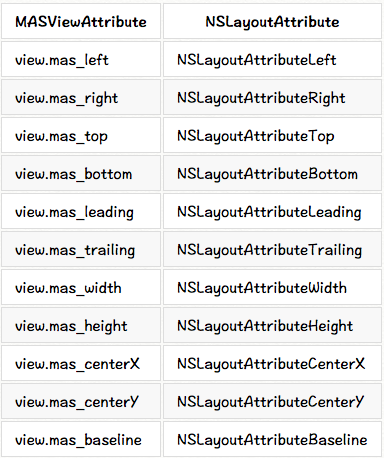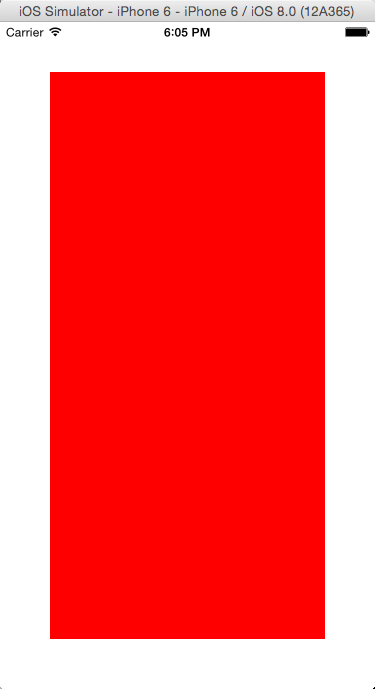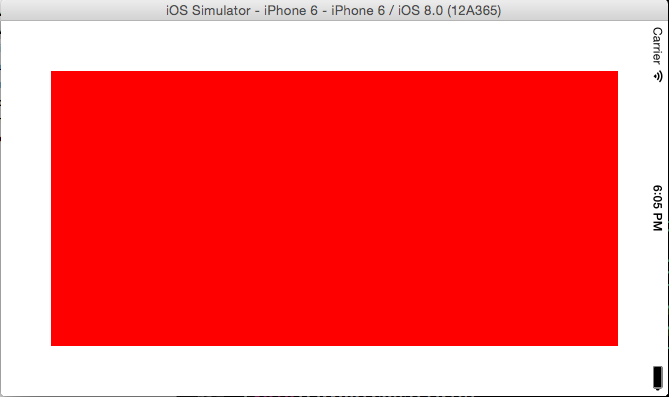Masonry练习详解
equalTo <=======> NSLayoutRelationEqual 等于
lessThanOrEqualTo <======> NSLayoutRelationLessThanOrEqual 小于或等于
greaterThanOrEqualTo <=======> NSLayoutRelationGreaterThanOrEqual 大于或等于
MASViewAttribute:视图约束属性

make.width.greaterThanOrEqualTo(@200);
make.width.lessThanOrEqualTo(@400)<2>//creates view.left = view.superview.left + 10make.left.lessThanOrEqualTo(@10)代替NSNumber,使用原始的数据或者结构体设置约束数据make.top.mas_equalTo(42);
make.height.mas_equalTo(20);
make.size.mas_equalTo(CGSizeMake(50, 100));
make.edges.mas_equalTo(UIEdgeInsetsMake(10, 0, 10, 0));
make.left.mas_equalTo(view).mas_offset(UIEdgeInsetsMake(10, 0, 10, 0)); 使用数组NSArray设置约束make.height.equalTo(@[view1.mas_height, view2.mas_height]);
make.height.equalTo(@[view1, view2]);
make.left.equalTo(@[view1, @100, view3.right]);.priorityHigh <======> UILayoutPriorityDefaultHigh 高优先级
.priorityMedium <========> between high and low 介于高/低之间
.priorityLow <=========> UILayoutPriorityDefaultLow 低优先级
make.left.greaterThanOrEqualTo(label.mas_left).with.priorityLow();
make.top.equalTo(label.mas_top).with.priority(600);// make top, left, bottom, right equal view2
make.edges.equalTo(view2);
// make top = superview.top + 5, left = superview.left + 10,
// bottom = superview.bottom - 15, right = superview.right - 20
make.edges.equalTo(superview).insets(UIEdgeInsetsMake(5, 10, 15, 20))// All edges but the top should equal those of the superview
make.left.right.and.bottom.equalTo(superview);
make.top.equalTo(otherView); // make width and height greater than or equal to titleLabel
make.size.greaterThanOrEqualTo(titleLabel)
// make width = superview.width + 100, height = superview.height - 50
make.size.equalTo(superview).sizeOffset(CGSizeMake(100, -50))// make centerX and centerY = button1
make.center.equalTo(button1)
// make centerX = superview.centerX - 5, centerY = superview.centerY + 10
make.center.equalTo(superview).centerOffset(CGPointMake(-5, 10))// in public/private interface
@property (nonatomic, strong) MASConstraint *topConstraint;
...
// when making constraints
[view1 mas_makeConstraints:^(MASConstraintMaker *make) {
self.topConstraint = make.top.equalTo(superview.mas_top).with.offset(padding.top);
make.left.equalTo(superview.mas_left).with.offset(padding.left);
}];
...
// then later you can call
[self.topConstraint uninstall]; 2.更新约束 mas_updateConstraints- (void)updateConstraints {
[self.growingButton mas_updateConstraints:^(MASConstraintMaker *make) {
make.center.equalTo(self);
make.width.equalTo(@(self.buttonSize.width)).priorityLow();
make.height.equalTo(@(self.buttonSize.height)).priorityLow();
make.width.lessThanOrEqualTo(self);
make.height.lessThanOrEqualTo(self);
}];
//according to apple super should be called at end of method
[super updateConstraints];
} 3.重新设置mas_remakeConstraints- (void)changeButtonPosition { [self.button mas_remakeConstraints:^(MASConstraintMaker *make) {
make.size.equalTo(self.buttonSize);
if (topLeft) {
make.top.and.left.offset(10);
} else {
make.bottom.and.right.offset(-10);
}
}];
}具体的实例如下:设置view1举例父视图的四周距离均为50
/** 方式一:使用NSLayoutConstraint实现手动布局 ---------------------------- 设置UIEdgeInsets ---------------------------- @interface UIView (UIConstraintBasedLayoutInstallingConstraints) - (NSArray *)constraints NS_AVAILABLE_IOS(6_0); - (void)addConstraint:(NSLayoutConstraint *)constraint NS_AVAILABLE_IOS(6_0); - (void)addConstraints:(NSArray *)constraints NS_AVAILABLE_IOS(6_0); - (void)removeConstraint:(NSLayoutConstraint *)constraint - (void)removeConstraints:(NSArray *)constraints NS_AVAILABLE_IOS(6_0); */ -(void)LayoutConstraint { UIView *superView = self.view; UIView *view1 = [[UIView alloc]init]; view1 .translatesAutoresizingMaskIntoConstraints = NO; view1.backgroundColor = [UIColor redColor]; [superView addSubview:view1]; //设置距离父视图边界距离 UIEdgeInsets pading = UIEdgeInsetsMake(50, 50, 50, 50); //添加给view1约束 [superView addConstraints:@[ [NSLayoutConstraint constraintWithItem:view1 attribute:NSLayoutAttributeTop relatedBy:NSLayoutRelationEqual toItem:superView attribute:NSLayoutAttributeTop multiplier:1.0 constant:pading.top], [NSLayoutConstraint constraintWithItem:view1 attribute:NSLayoutAttributeLeft relatedBy:NSLayoutRelationEqual toItem:superView attribute:NSLayoutAttributeLeft multiplier:1.0 constant:pading.left], [NSLayoutConstraint constraintWithItem:view1 attribute:NSLayoutAttributeBottom relatedBy:NSLayoutRelationEqual toItem:superView attribute:NSLayoutAttributeBottom multiplier:1.0 constant:-pading.bottom], [NSLayoutConstraint constraintWithItem:view1 attribute:NSLayoutAttributeRight relatedBy:NSLayoutRelationEqual toItem:superView attribute:NSLayoutAttributeRight multiplier:1.0 constant:-pading.right], ]]; }
/** 方法二:使用block @implementation MAS_VIEW (MASAdditions) ---------------------------- 设置offset偏移 或者 边缘edges ---------------------------- - (NSArray *)mas_makeConstraints:(void(^)(MASConstraintMaker *))block - (NSArray *)mas_updateConstraints:(void(^)(MASConstraintMaker *))block - (NSArray *)mas_remakeConstraints:(void(^)(MASConstraintMaker *make))block */ -(void)LayoutForMASConstraintMaker { UIView *superView = self.view; UIView *view1 = [[UIView alloc]init]; view1.backgroundColor = [UIColor redColor]; [superView addSubview:view1]; //设置距离父视图边界距离 UIEdgeInsets pading = UIEdgeInsetsMake(50, 50, 50, 50); //添加给view1约束 [view1 mas_makeConstraints:^(MASConstraintMaker *make) { make.top.equalTo(superView.mas_top).with.offset(pading.top); make.left.equalTo(superView.mas_left).with.offset(pading.left); make.bottom.equalTo(superView.mas_bottom).with.offset(-pading.bottom); make.right.equalTo(superView.mas_right).with.offset(-pading.right); //设置代码可以更简单(效果与上面的是一样的) //make.edges.equalTo(superView).with.insets(pading); }]; }
/** 方式三:使用block @implementation MAS_VIEW (MASAdditions) ---------------------------- 设置margin距离 ---------------------------- - (NSArray *)mas_makeConstraints:(void(^)(MASConstraintMaker *))block - (NSArray *)mas_updateConstraints:(void(^)(MASConstraintMaker *))block - (NSArray *)mas_remakeConstraints:(void(^)(MASConstraintMaker *make))block */ -(void)LayoutForMASConstraintMakerWithMargin { UIView *superView = self.view; UIView *view1 = [[UIView alloc]init]; view1.backgroundColor = [UIColor redColor]; [superView addSubview:view1]; //添加给view1约束 [view1 mas_makeConstraints:^(MASConstraintMaker *make) { make.topMargin.equalTo(superView.mas_top).with.offset(50); make.leftMargin.equalTo(superView.mas_left).with.offset(50); make.bottomMargin.equalTo(superView.mas_bottom).with.offset(-50); make.rightMargin.equalTo(superView.mas_right).with.offset(-50); }]; }
/** 方式四:使用block @implementation MAS_VIEW (MASAdditions) ---------------------------- 设置center和size ---------------------------- - (NSArray *)mas_makeConstraints:(void(^)(MASConstraintMaker *))block - (NSArray *)mas_updateConstraints:(void(^)(MASConstraintMaker *))block - (NSArray *)mas_remakeConstraints:(void(^)(MASConstraintMaker *make))block */ -(void)LayoutForMASConstraintMakerWithCenterWidthHeight { UIView *superView = self.view; UIView *view1 = [[UIView alloc]init]; view1.backgroundColor = [UIColor redColor]; [superView addSubview:view1]; //添加给view1约束 [view1 mas_makeConstraints:^(MASConstraintMaker *make) { make.centerX.equalTo(superView); make.centerY.equalTo(superView); make.size.equalTo(superView).sizeOffset(CGSizeMake(-100,-100)); }]; }

